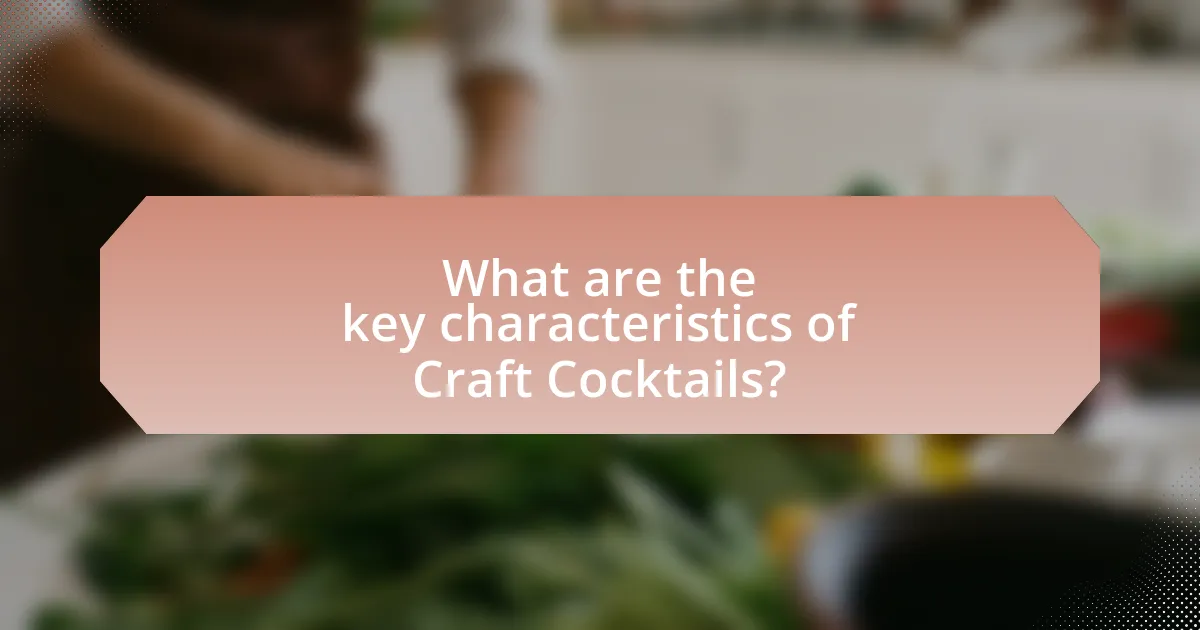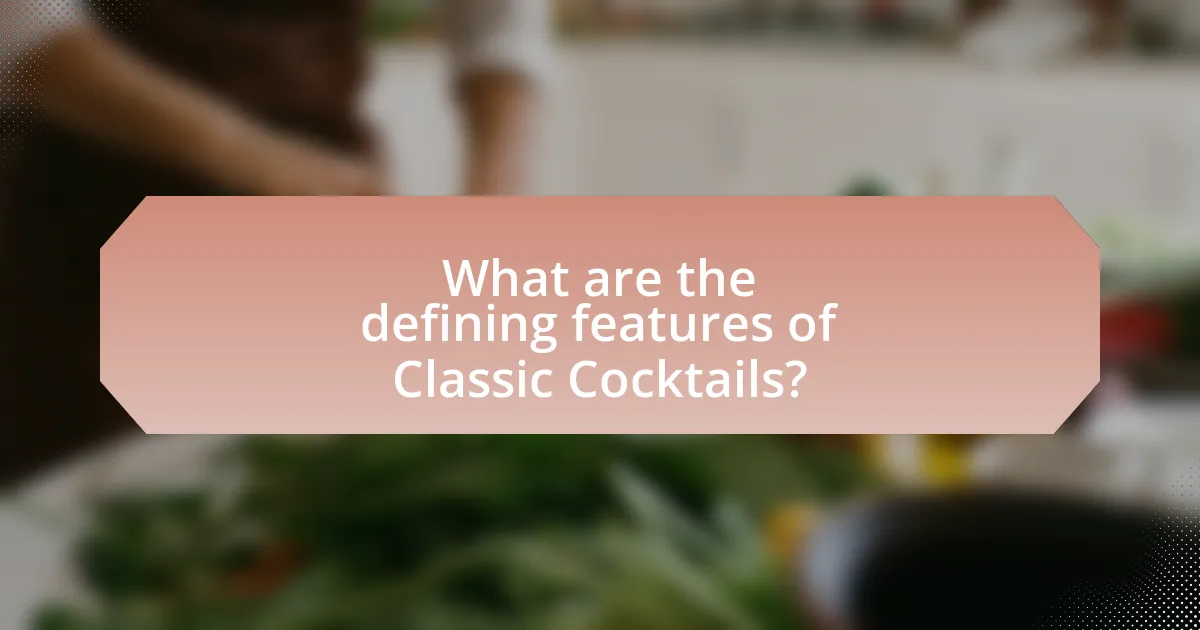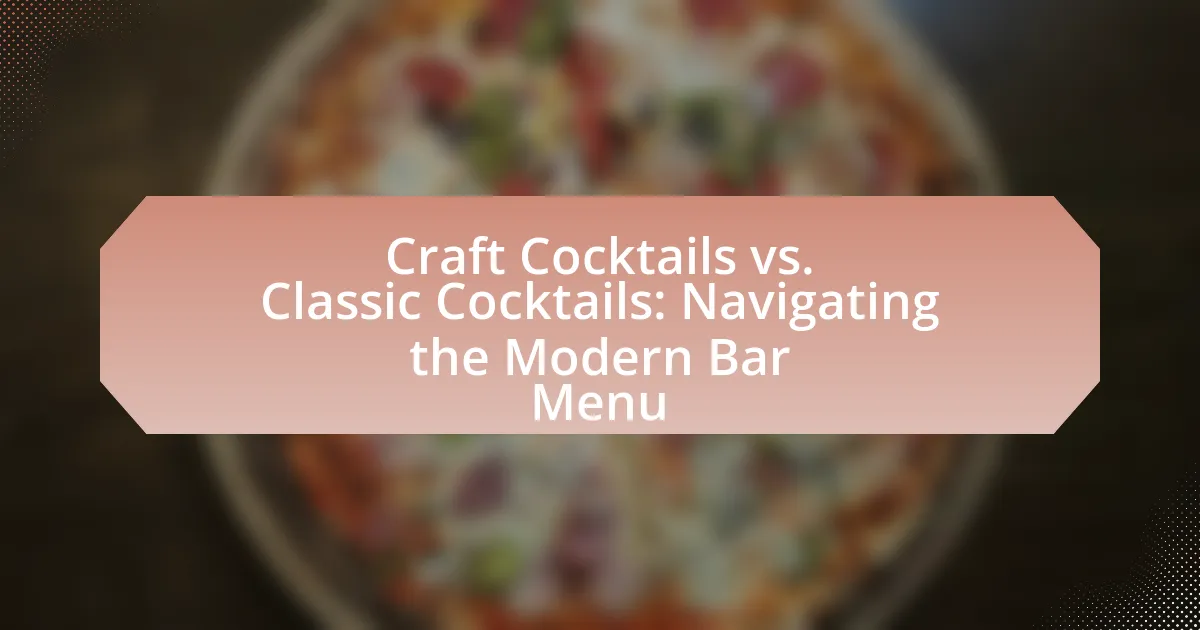Craft cocktails and classic cocktails represent two distinct approaches to mixology, each with unique characteristics and preparation methods. Craft cocktails emphasize creativity, high-quality ingredients, and artisanal techniques, often incorporating fresh herbs, house-made syrups, and innovative flavor combinations. In contrast, classic cocktails adhere to traditional recipes and established flavor profiles, showcasing historical significance and simplicity. The article explores the differences between these two categories, the ingredients commonly used, the impact of social media on cocktail trends, and the techniques essential for their preparation. Additionally, it highlights the growing popularity of craft cocktails and the enduring appeal of classic cocktails in modern drinking culture.

What are Craft Cocktails and Classic Cocktails?
Craft cocktails are innovative drinks made with high-quality ingredients, often featuring unique flavor combinations and artisanal techniques, while classic cocktails are traditional drinks that have stood the test of time, typically following established recipes and using standard ingredients. Craft cocktails emphasize creativity and personalization, often incorporating fresh herbs, house-made syrups, and specialty spirits, whereas classic cocktails, such as the Martini or Old Fashioned, rely on a set formula that has been widely recognized and replicated since their inception in the late 19th and early 20th centuries. The distinction lies in the approach to preparation and presentation, with craft cocktails reflecting contemporary trends and classic cocktails embodying historical significance in the cocktail culture.
How do Craft Cocktails differ from Classic Cocktails?
Craft cocktails differ from classic cocktails primarily in their emphasis on creativity, quality ingredients, and artisanal techniques. While classic cocktails are typically based on established recipes and traditional methods, craft cocktails often involve innovative combinations of flavors, unique ingredients, and meticulous preparation methods. For instance, craft cocktails may utilize house-made syrups, fresh herbs, and specialty spirits, reflecting a trend towards personalization and experimentation in mixology. This distinction highlights the evolution of cocktail culture, where craft cocktails represent a modern approach that prioritizes the overall drinking experience and the artistry of the bartender.
What ingredients are typically used in Craft Cocktails?
Craft cocktails typically use high-quality spirits, fresh ingredients, and unique flavorings. Common ingredients include artisanal spirits like small-batch gin or whiskey, fresh fruits such as citrus or berries, herbs like mint or basil, and house-made syrups or bitters. The emphasis on freshness and quality distinguishes craft cocktails from classic cocktails, which may rely on more standardized ingredients. This focus on premium components enhances the overall flavor profile and presentation, making craft cocktails a popular choice in modern bars.
What ingredients are typically used in Classic Cocktails?
Classic cocktails typically use ingredients such as spirits, bitters, sugar, and citrus. For example, a Martini is made with gin and vermouth, while a Manhattan combines whiskey, sweet vermouth, and bitters. These foundational components have been established in cocktail culture since the late 19th century, reflecting a balance of flavors that defines classic mixology.
Why has the popularity of Craft Cocktails surged in recent years?
The popularity of craft cocktails has surged in recent years due to a growing consumer preference for unique, high-quality beverages that emphasize artisanal ingredients and innovative techniques. This trend is supported by the rise of mixology as a recognized profession, where bartenders are trained to create complex flavors and presentations, enhancing the overall drinking experience. Additionally, the craft cocktail movement has been fueled by social media, which allows for the sharing of visually appealing drinks and creative recipes, further driving interest and demand. According to a report by the Distilled Spirits Council, the craft cocktail segment has seen significant growth, with sales increasing by over 20% in the past five years, reflecting a shift in consumer behavior towards premium and personalized drinking experiences.
What trends have influenced the rise of Craft Cocktails?
The rise of craft cocktails has been influenced by several key trends, including the emphasis on artisanal ingredients, the revival of classic cocktail recipes, and the growing consumer interest in unique flavor profiles. Artisanal ingredients, such as small-batch spirits and locally sourced produce, have become popular as consumers seek higher quality and authenticity in their drinks. The revival of classic cocktail recipes has led to a renewed appreciation for traditional techniques and presentations, often enhanced by modern twists. Additionally, the trend towards experiential dining has encouraged bars to create innovative and visually appealing cocktails that offer a unique experience, catering to consumers’ desires for both taste and aesthetics. These trends collectively reflect a shift towards a more sophisticated and personalized drinking culture.
How do social media and culture impact cocktail preferences?
Social media and culture significantly influence cocktail preferences by shaping trends and promoting specific styles of drinks. Platforms like Instagram and TikTok showcase visually appealing cocktails, leading to increased demand for craft cocktails that emphasize unique ingredients and presentation. For instance, a study by the Journal of Consumer Research found that social media exposure can enhance consumer interest in novel products, including cocktails, as users seek to replicate popular trends seen online. Additionally, cultural factors, such as regional tastes and historical influences, further dictate preferences, with certain cocktails gaining popularity in specific demographics or locations due to cultural significance or social gatherings.

What are the key characteristics of Craft Cocktails?
Craft cocktails are defined by their emphasis on high-quality ingredients, artisanal preparation, and innovative flavor combinations. These cocktails typically utilize fresh, seasonal ingredients, house-made syrups, and unique bitters, distinguishing them from classic cocktails that often rely on standard mixers and pre-made components. The craft cocktail movement prioritizes creativity and presentation, often featuring intricate garnishes and bespoke glassware, which enhances the overall drinking experience. Additionally, craft cocktails are usually prepared by skilled mixologists who focus on technique and balance, ensuring that each drink is not only visually appealing but also well-balanced in flavor.
How is the preparation of Craft Cocktails different?
The preparation of craft cocktails differs from classic cocktails primarily in the emphasis on artisanal techniques and high-quality, often house-made ingredients. Craft cocktails typically involve a more intricate process, including the use of fresh herbs, spices, and unique flavor combinations, which are often prepared in-house, such as syrups and bitters. This approach contrasts with classic cocktails, which generally rely on standardized recipes and commercially available ingredients. The craft cocktail movement prioritizes creativity and presentation, often resulting in visually striking drinks that reflect the bartender’s personal style and the establishment’s theme.
What techniques are commonly used in Craft Cocktail preparation?
Common techniques used in craft cocktail preparation include shaking, stirring, muddling, layering, and infusing. Shaking is employed to mix ingredients thoroughly and chill the drink, while stirring is used for cocktails that require a gentler mixing to maintain clarity and texture. Muddling involves crushing ingredients, such as herbs or fruits, to release their flavors. Layering is a technique that creates visually appealing drinks by carefully pouring liquids of different densities. Infusing involves steeping ingredients, like herbs or spices, in spirits to enhance flavor profiles. These techniques are essential for creating complex and balanced flavors in craft cocktails.
How does presentation play a role in Craft Cocktails?
Presentation significantly enhances the experience of craft cocktails by engaging the senses and creating a visual appeal that complements the drink’s flavor profile. The aesthetic elements, such as glassware, garnishes, and color, contribute to the overall enjoyment and perception of quality. Research indicates that visually appealing drinks can increase customer satisfaction and willingness to pay, as seen in studies where participants rated cocktails higher when presented attractively. This underscores the importance of presentation in elevating the craft cocktail experience, making it not just a beverage but a holistic sensory event.
What are the flavor profiles typically found in Craft Cocktails?
Craft cocktails typically feature complex flavor profiles that include a balance of sweet, sour, bitter, and umami elements. These cocktails often incorporate artisanal ingredients such as fresh herbs, house-made syrups, and unique bitters, which enhance their depth and character. For example, a craft cocktail may combine citrus juices with herbal infusions and a touch of sweetness from natural sweeteners, creating a layered taste experience. The use of high-quality spirits and innovative flavor combinations is a hallmark of craft cocktails, distinguishing them from classic cocktails that may rely on simpler, more traditional flavor profiles.
How do seasonal ingredients affect Craft Cocktail flavors?
Seasonal ingredients significantly enhance craft cocktail flavors by introducing freshness and unique taste profiles that reflect the time of year. For example, summer cocktails often feature fruits like berries and citrus, which provide bright, refreshing notes, while winter cocktails may incorporate spices and hearty flavors such as cinnamon or nutmeg, creating warmth and depth. The use of seasonal ingredients not only aligns with the natural growing cycles but also allows bartenders to craft cocktails that resonate with current culinary trends and local availability, ensuring a more vibrant and dynamic drinking experience. This approach is supported by the farm-to-table movement, which emphasizes the importance of using fresh, locally sourced ingredients to elevate flavor and sustainability in the beverage industry.
What role do bitters and syrups play in Craft Cocktails?
Bitters and syrups are essential components in craft cocktails, serving to enhance flavor complexity and balance. Bitters, which are concentrated flavoring agents made from herbs, spices, and botanicals, add depth and a layer of aromatic complexity to cocktails. For example, Angostura bitters, a common choice, can introduce notes of spice and bitterness that complement the sweetness of other ingredients. Syrups, on the other hand, provide sweetness and can be infused with various flavors, such as fruit or herbs, to create a harmonious blend. The use of simple syrup or flavored syrups allows bartenders to achieve the desired sweetness while maintaining the cocktail’s overall balance. Together, bitters and syrups contribute to the intricate flavor profiles that define craft cocktails, making them distinct from classic cocktails, which may rely more heavily on base spirits and fewer modifiers.

What are the defining features of Classic Cocktails?
Classic cocktails are characterized by their adherence to traditional recipes, balanced flavor profiles, and the use of high-quality ingredients. These cocktails often feature a specific combination of spirits, bitters, and modifiers, such as vermouth or fruit juices, which create a harmonious taste. Historical significance also defines classic cocktails, as many originated in the 19th and early 20th centuries, reflecting the cocktail culture of that era. Notable examples include the Martini, Old Fashioned, and Manhattan, each with a distinct preparation method and presentation style that emphasizes simplicity and elegance.
How do Classic Cocktails maintain their timeless appeal?
Classic cocktails maintain their timeless appeal through their simplicity, balance of flavors, and historical significance. These drinks, such as the Martini and Old Fashioned, are rooted in tradition, often featuring a limited number of high-quality ingredients that allow for a harmonious taste profile. Their enduring popularity is also supported by cultural references and the nostalgia they evoke, as many classic cocktails have been enjoyed for over a century, making them a staple in bars worldwide. The consistent preparation methods and classic recipes ensure that they remain recognizable and reliable choices for consumers, reinforcing their status in the cocktail landscape.
What are some iconic Classic Cocktails and their histories?
Some iconic classic cocktails include the Martini, Old Fashioned, and Manhattan, each with rich histories. The Martini, believed to have originated in the mid-19th century, gained popularity through its association with high society and was famously featured in James Bond novels. The Old Fashioned, dating back to the early 1800s, was initially referred to as a “whiskey cocktail” and became known for its simplicity and use of bitters. The Manhattan, created in the 1860s at the Manhattan Club in New York City, is a blend of rye whiskey, sweet vermouth, and bitters, symbolizing the sophistication of cocktail culture during that era. These cocktails not only reflect the tastes of their times but also have influenced modern mixology.
How do Classic Cocktails reflect historical drinking culture?
Classic cocktails reflect historical drinking culture by embodying the social customs, ingredients, and techniques prevalent during their time of creation. For instance, the Martini, which gained popularity in the late 19th century, showcases the shift towards dry vermouth and gin, aligning with the era’s preference for refined and sophisticated drinks. Additionally, the Old Fashioned, originating in the early 1800s, illustrates the transition from punch-based drinks to spirit-forward cocktails, highlighting a growing appreciation for individual flavors and craftsmanship in mixology. These cocktails serve as cultural artifacts, revealing societal norms, economic conditions, and regional tastes that shaped drinking habits throughout history.
What techniques are essential for making Classic Cocktails?
Essential techniques for making Classic Cocktails include shaking, stirring, muddling, and layering. Shaking is used for cocktails that contain juices or other ingredients that need to be mixed thoroughly, such as a Daiquiri. Stirring is employed for spirit-forward drinks like a Manhattan, ensuring a smooth blend without dilution. Muddling involves crushing ingredients, typically herbs or fruits, to release their flavors, as seen in a Mojito. Layering is a technique used to create visually appealing drinks by carefully pouring liquids of different densities, exemplified in a Pousse Café. These techniques are foundational in cocktail preparation, ensuring balance and flavor integrity in classic recipes.
What tools are necessary for preparing Classic Cocktails?
To prepare Classic Cocktails, essential tools include a cocktail shaker, jigger, bar spoon, strainer, muddler, and a mixing glass. The cocktail shaker is used for mixing and chilling ingredients, while the jigger measures precise quantities of spirits. A bar spoon aids in stirring and layering drinks, and a strainer ensures smooth pouring by filtering out solids. A muddler is necessary for crushing herbs or fruits, and a mixing glass is used for cocktails that require stirring rather than shaking. These tools are fundamental in achieving the balance and presentation characteristic of Classic Cocktails.
How does the balance of flavors work in Classic Cocktails?
The balance of flavors in classic cocktails is achieved through the harmonious interplay of sweet, sour, bitter, and strong elements. Classic cocktails, such as the Martini or the Daiquiri, typically follow a formula that combines these flavor profiles in specific ratios, ensuring that no single flavor overpowers the others. For instance, a classic Daiquiri consists of rum (strong), lime juice (sour), and simple syrup (sweet), with the proportions adjusted to create a balanced taste. This balance is crucial because it enhances the overall drinking experience, allowing each component to complement rather than compete with one another. Historical cocktail recipes often emphasize this balance, as seen in the original formulation of the Old Fashioned, which combines whiskey (strong), sugar (sweet), and bitters (bitter) to create a well-rounded flavor profile.
How can one navigate a modern bar menu effectively?
To navigate a modern bar menu effectively, one should familiarize themselves with the categories of drinks offered, such as craft cocktails, classic cocktails, and non-alcoholic options. Understanding the ingredients and flavor profiles of these categories allows patrons to make informed choices. For instance, craft cocktails often feature unique ingredients and innovative techniques, while classic cocktails adhere to traditional recipes. Additionally, asking the bartender for recommendations based on personal taste preferences can enhance the experience, as bartenders typically have extensive knowledge of the menu and can suggest drinks that align with individual palates. This approach not only aids in selecting a drink but also fosters engagement with the bar staff, enriching the overall experience.
What tips can enhance the experience of choosing between Craft and Classic Cocktails?
To enhance the experience of choosing between Craft and Classic Cocktails, consider the following tips: first, understand the key differences; Craft Cocktails often feature unique ingredients and innovative techniques, while Classic Cocktails are based on traditional recipes. Familiarizing yourself with the flavor profiles of both types can guide your choice. Additionally, ask the bartender for recommendations based on your taste preferences, as they can provide insights into the best options available. Exploring seasonal ingredients in Craft Cocktails can also lead to discovering fresh and exciting flavors. Lastly, consider the ambiance of the bar; some venues specialize in Craft Cocktails, while others may focus on Classic offerings, influencing your overall experience.


